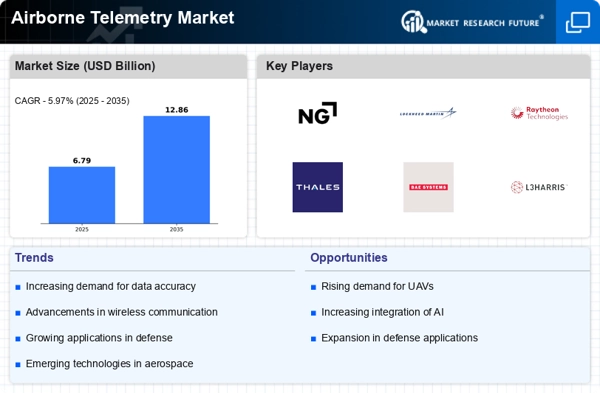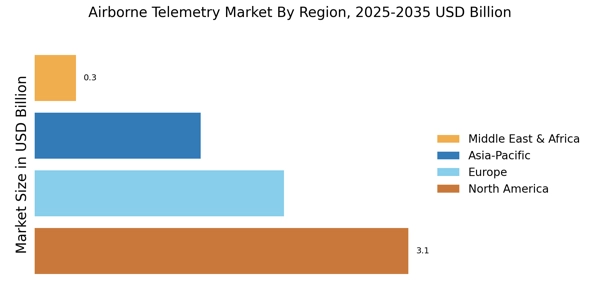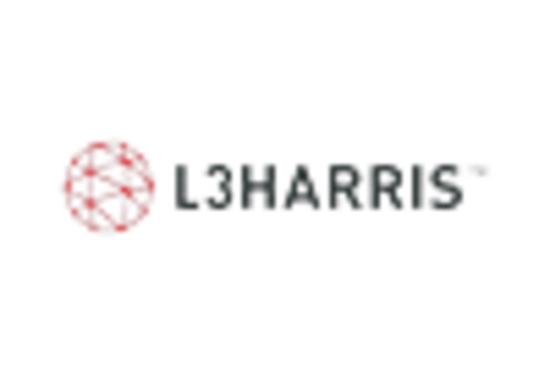Integration with Autonomous Systems
The Airborne Telemetry Market is being propelled by the integration of telemetry systems with autonomous technologies. As industries explore automation in various applications, the need for reliable telemetry data becomes paramount. Autonomous vehicles, drones, and robotic systems rely on telemetry for navigation, performance monitoring, and safety assurance. The market for autonomous systems is projected to grow significantly, with estimates suggesting a compound annual growth rate of 15% over the next five years. This growth is likely to drive demand for advanced telemetry solutions that can seamlessly integrate with these systems. Consequently, the Airborne Telemetry Market is expected to benefit from this trend, as companies seek to enhance the capabilities of their autonomous technologies through improved data transmission and analysis.
Increasing Demand for Real-Time Data
The Airborne Telemetry Market is experiencing a surge in demand for real-time data transmission. This trend is largely driven by the need for immediate information in various sectors, including defense, aerospace, and research. As organizations increasingly rely on timely data for decision-making, the telemetry systems that provide this capability are becoming essential. The market is projected to grow at a compound annual growth rate of approximately 8.5% over the next five years, indicating a robust expansion. This growth is fueled by advancements in satellite communication and data processing technologies, which enhance the efficiency and reliability of airborne telemetry systems. Consequently, companies are investing in innovative solutions to meet the rising expectations for data accuracy and speed, thereby propelling the Airborne Telemetry Market forward.
Emergence of Advanced Sensor Technologies
The Airborne Telemetry Market is witnessing a transformative phase due to the emergence of advanced sensor technologies. These innovations enable more precise data collection and transmission, which is crucial for applications in environmental monitoring, disaster management, and scientific research. The integration of high-resolution sensors into telemetry systems allows for the gathering of extensive data sets, which can be analyzed for various purposes. As organizations increasingly recognize the value of detailed data, the demand for sophisticated telemetry solutions is expected to rise. Market analysts predict that the adoption of these advanced sensors will contribute to a market growth rate of around 7% over the next few years. This trend indicates that the Airborne Telemetry Market is poised for significant advancements, driven by technological progress and the need for enhanced data accuracy.
Growing Focus on Environmental Monitoring
The Airborne Telemetry Market is increasingly aligned with the growing focus on environmental monitoring. As concerns about climate change and natural disasters escalate, there is a pressing need for effective data collection methods to assess environmental conditions. Airborne telemetry systems are uniquely positioned to provide critical data on atmospheric changes, pollution levels, and wildlife tracking. Governments and organizations are investing in these technologies to enhance their monitoring capabilities. Recent reports suggest that investments in environmental telemetry solutions are expected to increase by 10% annually, reflecting a strong commitment to sustainability. This trend indicates that the Airborne Telemetry Market will likely expand as stakeholders seek to leverage telemetry systems for better environmental stewardship and informed policy-making.
Expansion of Aerospace and Defense Sectors
The Airborne Telemetry Market is significantly influenced by the expansion of the aerospace and defense sectors. With increasing investments in military and civilian aviation, there is a heightened need for advanced telemetry systems to monitor aircraft performance and ensure safety. The defense sector, in particular, is focusing on developing sophisticated unmanned aerial vehicles (UAVs) that require robust telemetry solutions for effective operation. According to recent estimates, the defense budget allocations for technology upgrades are expected to rise by 5% annually, further driving the demand for telemetry systems. This trend suggests that as the aerospace and defense industries evolve, the Airborne Telemetry Market will likely see substantial growth, as these sectors seek to enhance operational capabilities and maintain competitive advantages.


















Leave a Comment